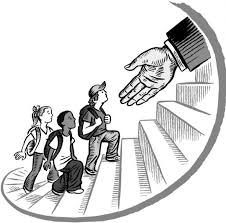By Victoria Phillips

The efforts to improve education and see through alternatives like charter schools is the responsibility of every one. Planners and other professionals alike have the knowledge and power to impact the future just as students themselves have the ability to speak up for what they believe their future should be.
To be able to overcome adversity and be the “one who got out of the ghetto” is a story to be celebrated but not one society can hang their hats one. Education inequality stunts the life of thousands of children’s (West & Nikolani, 2013). Though many would like to blame the students own lack of ambition or intelligence, that cannot simply be the only reason; even so there must be a system to counteract this, as every child has the right to an education.
Within the last two decades charter schools, public funded schools with the autonomy of a private school have provided an alternative to failing public schools. Institutions like Knowledge is Power (KIPP) and the Harlem Success Academy attest they strive to modernize the current education system, ultimately redefining what public education can offer (Our Mission, n.d.). In reality these institutions are seeking to equalize opportunity, close the gap of education inequality. For decades in the educational realm, this meant proportionately allocating resources across schools; now institutions are looking to equalize achievement (West & Nikolani, 2013).
Throughout their history charter schools have been continuously challenged to prove their alternative way to education is truly effective. Several large studies have been produced, most notably the National Charter School Study 2013, bringing into question charter schools ability to improve student test scores in comparison to traditional public schools (Sanchez, 2013). The study concluded, “In both subjects [math and reading], the trend since 2009 is on an upward trajectory, with the relative performance of the charter sector improving each year” (Cremata, Davis, Dickey, Lawyer, Negassi, Raymond, et al., 2013). Though charter schools are not superseding their traditional public school counterpart, these institutions have accomplished something just as profound.
It is imperative to acknowledge charter schools success in equalizing achievement between privileged and disadvantaged students. In the 2013 study of charter schools, more than 50 percent of the students lived in poverty (Cremata et al., 2013). Though many public schools face the same if not worse percentages of students at or below the poverty line, charter schools have reformed their education system to account for this adversity the majority of students face. Where in traditional public schools these students would often be failing out, unable to benefit from the educational experience due to their extenuating circumstances, schools like KIPP target low-income and minority students (Angrist, Dynarski, Kane, Pathak & Walters, 2012). The very fact that charter schools, whose student population would otherwise be failing out of school, is able to compete academically with the best of traditional public schools is remarkable and deserves recognition.

To graduate college in the end goal for many students. A wall like this one represents the dreams of thousands of students whose opportunity to attend college could be stunted by outside forces they cannot control.
Charter schools have become more than an educational institution, as they aim to retrofit the education system to mitigate the outside pressures the majority of their students face. KIPP, the nation’s largest charter management organization maintains the basic education curriculum foundation of math, reading, and science while enacting a longer school day and year, enforcing a higher standard of ethics and character, and removing the red tape of tenure and difficult firing procedures of teachers (Angrist et al., 2012). Their mission is value based and holds students and faculty to their own determined set of standards, often higher than that of a traditional public school.
Within the debate of charter schools success in comparison to traditional public schools, critics maintain charter schools only provide a viable educational forum for a select group of students (Cremata et al., 2013). This is true, just as traditional public schools are configured to benefit a particular group of students too. This discrepancy may be inadvertent but none the less it exists. Charter schools are public facilities placed in urban setting and areas of economic disparity, where the majority of their students, whether chosen by a lottery or not would be impoverished. It is wrong to downplay the incredible achievements charter schools have made in the American education system to equalize education achievement because they aim to help those students who are disadvantaged.

The struggles students face now more than ever are greater than just academic. Everyday many students carry the burden of socio-economic and other extenuating problems which impair their ability to learn at their maximum capacity. Charter schools aim to curb the adverse affects of these situations to provide a more conducive learning environment.
There is a shift in the American population demographics both ethnically and socio-economically which must be recognized. In regards to reviving the current flat-lining American education system, policy officials and others in power are failing to recognize the increase in non-English speaking students and a growing number of students in destitute living situations (Cremata et al., 2013). As planners we work to fulfill an ethical code, to provide social justice; thus we “shall seek to expand choice and opportunity for all persons, recognizing a special responsibility to plan for the needs of the disadvantaged groups and persons, and shall urge alteration of policies, institutions, and decisions which mitigates against such objectives” (American Institute of Planners [AIP] 1976). Planners can see the social demographic within the community which heavily impact the student’s ability to learn and from that local knowledge work with schools systems to configure learning systems conducive to its student population. Whether charter schools are the mode for this change in the American education system is still in question; regardless the results of charter schools have produced, given the adversity they face is commendable. They give validity to the need to tend to students emotional and mental needs as well as academic and alter the way in which society thinks about education.
References
American Institute of Planners. 1976. Roster. Washington DC: American Institute of Planners.
Angrist J. & Dynarski S. & Kane T. & Pathak P. & Walters C. , 2012. “Who Benefits from KIPP?,” Journal of Policy Analysis and Management, John Wiley & Sons, Ltd., vol. 31(4), pages 837-860, 09.
Cremata, E., Davis, D., Dickey, K., Lawyer, K., Negassi, Y., Raymond, M. E., et al. (2013). National Charter School Study. Stanford, Califorina: CREDO.
Our Approach. (n.d.). – KIPP Public Charter Schools. Retrieved November 20, 2013, from http://www.kipp.org/our-approach
Our Mission. (n.d.). Success Academy. Retrieved November 20, 2013, from http://www.successacademies.org/about-success-academy/
Sanchez, C. (2013, July 16). The Charter School Vs. Public School Debate Continues. NPR. Retrieved November 20, 2013, from http://www.npr.org/2013/07/16/201109021/the-charter-school-vs-public-school-debate-continues
West A. and Nikolani, R. (2013). Welfare Regimes and Education Regimes: Equality of Opportunity and Expenditure in the EU (and US). Journal of Social Policy, 42, pp 469-493. doi:10.1017/S0047279412001043.
